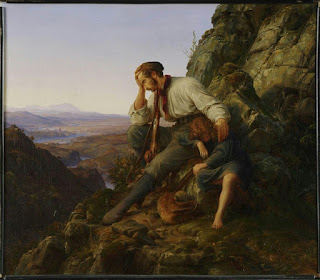Karl Friedrich Lessing mostly painted in and around Düsseldorf, where he attended academy between 1833-1843 and later influenced younger students. Lessing began as a traditional landscape painter, sketching in the country and painting canvas in the studio. After learning to create history paintings from Von Schadow-Godenhaus, he began to combine the genres. Lessing is credited as the inventor of this style of historical landscape painting, where figures referencing history or literature are are added to the landscapes.
The Robber and his Child is taken from a theme popular in German literature (and art) during the late eighteenth and early nineteenth centuries. The robber is a noble thief, forced to steal because of social injustice or the need to feed a family. The most notable of these heroic robbers came from Friedrich Schiller's Die Räuber of 1781. The depiction of man in isolation was also very popular within the Düsseldorf School around this time, so the theme of the noble robber enjoyed great success.
Lessing painted this picture for his friend, Carl Ferdinand Sohn, and it was reported that he also painted a later version for a collector in Berlin.
References:
Sutton, Peter C. Northern European Paintings in the Philadelphia Museum of Art. Philadelphia: Philadelphia Museum of Art, 1990.
Art:
Philadelphia Museum of Art, Philadelphia


No comments:
Post a Comment